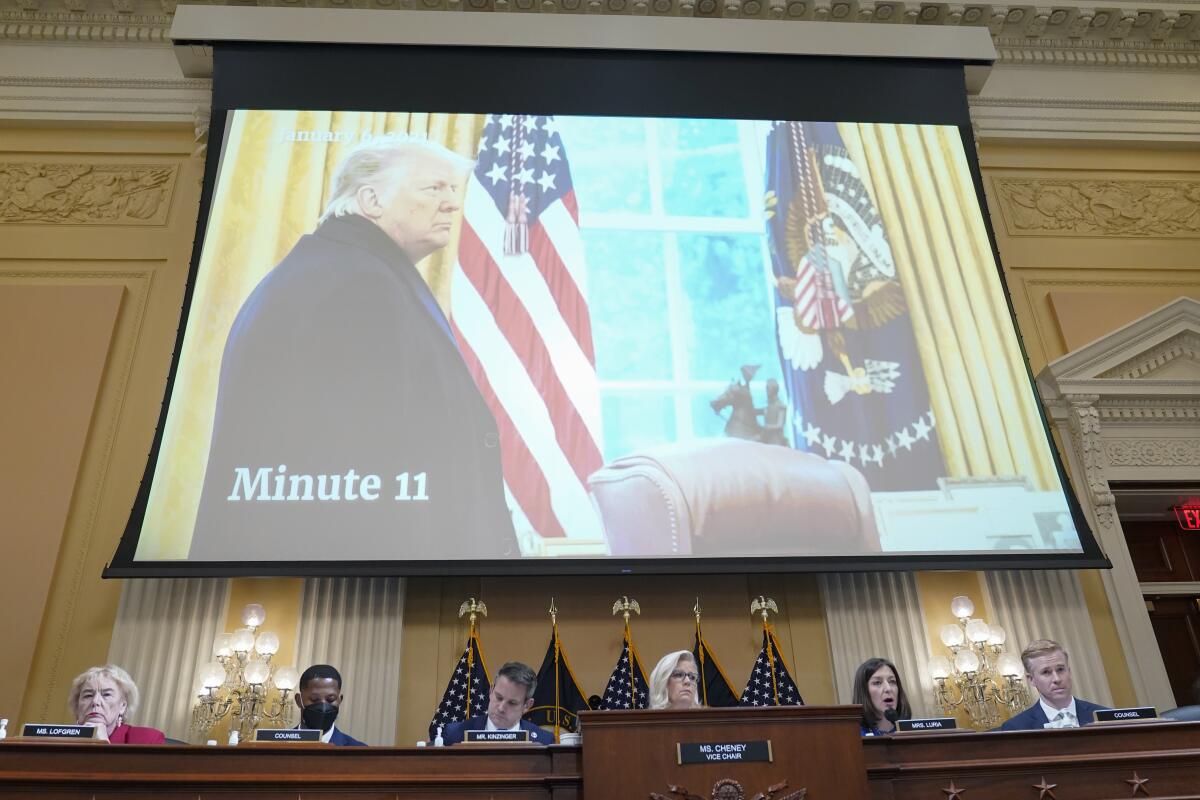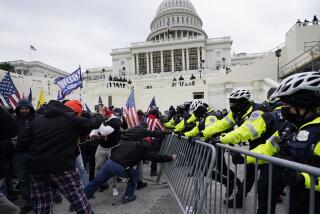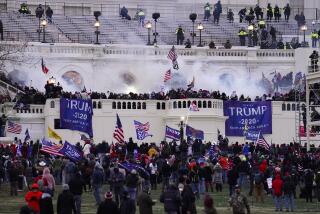‘Unbridled destructive energy’: Takeaways from Thursday’s hearing on the Jan. 6 insurrection

- Share via
WASHINGTON — The House Jan. 6 committee offered new details Thursday about the 187 minutes — from 1:10 pm to 4:17 pm — that elapsed between the end of President Trump’s speech to supporters near the White House and the video he put out urging the mob storming the Capitol to go home.
The committee showed that Trump spent most of those three hours in the White House dining room. As Fox News played in the background, the former president called senators to urge them to help delay the electoral count and ignored pleas from his advisors to help end the insurrection.
“For 187 minutes on January 6, [2021], this man of unbridled destructive energy could not be moved,” Chairman Bennie Thompson (D-Miss) said at the start of the hearing.
Here are four key takeaways from the hearing:
Trump’s hours in the White House dining room
The White House records of what happened during the insurrection are limited. There were no details in the official call log, nothing recorded in the White House Daily Diary and no photos taken.
Several witnesses who testified in depositions before the committee said they weren’t aware of the president reaching out to law enforcement agencies for help. Instead, he was making calls in an attempt to secure another term. Former White House press secretary Kayleigh McEnany testified that Trump asked her for a list of senators to contact, which she left with him.
Trump also spoke with his lawyer, Rudolph W. Giuliani, according to Giuliani’s phone records.
Later in the afternoon, as Vice President Mike Pence was evacuated from the Capitol, the president called Sen. Tommy Tuberville (R-Ala.). The senator later told a local news outlet that he had to end the call with the president because he was also being evacuated.
Trump, Meadows were bombarded with requests to send mob home
Several Trump staffers, members of Congress, conservative media personalities and members of the president’s own family either urged Trump directly to call off the rioters or contacted his chief of staff Mark Meadows to make their pleas.
According to witnesses and text message records, that list included former White House Counsel Pat Cipollone; Trump’s children, Ivanka Trump and Donald Trump Jr.; Fox News’ Sean Hannity, Laura Ingraham and Brian Kilmeade; Republican Reps. Chip Roy of Texas, Jeff Duncan of South Carolina, Barry Loudermilk of Georgia; and House Minority Leader Kevin McCarthy.
Jared Kushner, Trump’s son-in-law, testified that McCarthy also called him, asking for any help possible.
“I got the sense that they were scared,” Kushner said.
Sarah Matthews, a former deputy press secretary and special assistant to the president, said it would have taken Trump less than 60 seconds to walk from the dining room to the press briefing room to address the public. It would have taken a few minutes to assemble the White House press corps to cover remarks from the Oval Office, she said.
“If the president had wanted to make a statement and address the American people, he could have been on camera almost instantly,” she said.
Rep. Adam Kinzinger (R-Ill.), who helped lead Thursday’s hearing with Rep. Elaine Luria (D-Va.) and committee Vice Chair Liz Cheney (R-Wyo.), said there were concerns among the president’s team that his unscripted comments could cause further damage.
“For example, Gen. Keith Kellogg told us that some staff were concerned that a live appearance by the president at the microphones at that moment could actually make matters worse,” Kinzinger said, referring to Pence’s former national security advisor. “He told us he recommended against doing a press conference because during his four years in the Trump administration, ‘There wasn’t a single clean press conference.’”
Trump’s Jan. 6 tweet on Pence came as he was being evacuated
At 2:24 p.m. that day, Trump tweeted that Pence “didn’t have the courage to do what should have been done.”
As the insurrection unfolded, the president’s national security council staff was listening to radio traffic of the Secret Service agents protecting Pence.
At 2:13 p.m., a national security council staffer noted that the windows of the Capitol were being kicked in, according to excerpts from the staffer’s chat box. Three minutes later a staffer wrote Pence was being pulled out. As the Trump tweet went out, a staffer wrote that the agents protecting Pence didn’t “sound good.”
A White House security official the committee allowed to testify anonymously said the vice president’s security detail feared for their lives and were calling to say goodbye to family members.
Matthews and Matthew Pottinger, a former deputy national security advisor to Trump, testified before the panel Thursday and said the tweet inflamed the situation.
“It was essentially him giving the green light to these people,” Matthews said. “He shouldn’t have been doing that. He should have been telling these people to go home and to leave, and to condemn the violence that we were seeing.”
She said the tweet was Trump “pouring gasoline on the fire and making things much worse.”
What happened after Trump finally told the rioters to leave
Witnesses also described the efforts in the White House and the Capitol to resume the electoral count and reassure the public — and those watching around the world — that there would be a peaceful transition of power in the hours and days following the attack.
Then-Senate Majority Leader Mitch McConnell (R-Ky.) and Minority Leader Chuck Schumer (D-N.Y.) asked officials when it would be safe to return to the Capitol. After the president’s Twitter account was suspended on Jan. 6, Trump advisor Jason Miller urged the president to say in a tweet from deputy chief of staff Dan Scavino’s account that there would still be an “orderly transition” of power.
Former Secretary of Labor Eugene Scalia sent a memo to the president requesting a Cabinet meeting to show that the president was listening to them and not “certain private individuals” who had served him “poorly” with their advice.
“Though Secretary Scalia did not say it, he was referring to Rudy Giuliani and the rest of the so-called ‘clown car’ working with President Trump to try to overturn the election,” Kinzinger said. Scalia also asked the president to stop publicly challenging the results of the election.
Inside the White House, staffers sought to control the fallout from Jan. 6. Amid fears that the Cabinet would invoke the 25th Amendment to remove him from power, the president recorded another video message on Jan. 7 to condemn the attack. But, as raw footage from that video shows, he was still unwilling to say he lost the election.
“I don’t want to say the election is over,” Trump said in a clip. “I just want to say Congress has certified the results.”
More to Read
Get the L.A. Times Politics newsletter
Deeply reported insights into legislation, politics and policy from Sacramento, Washington and beyond. In your inbox three times per week.
You may occasionally receive promotional content from the Los Angeles Times.











